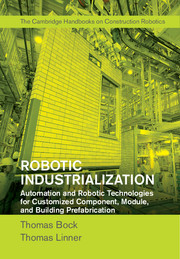 Robotic Industrialization
Robotic Industrialization Published online by Cambridge University Press: 05 August 2015
In this volume, concepts, technologies, and developments in the field of building component manufacturing (BCM, outlined in Chapter 2) based on concrete, brickwork, wood, and steel materials, as well as building module manufacturing (outlined in Chapter 3) and large-scale prefabrication (LSP, outlined in Chapters 4 and 5) with the potential to deliver complex components and products, are introduced and discussed. BCM refers to the transformation of materials, parts and low-level components into higher level components through the use of highly mechanized, automated, or robot-supported industrial settings. The definitions of components share a common element; they are, more or less, a complex combination of individual preexisting basic elements, parts and/or lower level components. BCM should also be distinguished from the manufacturing of more complex modules (e.g., prefabricated bath modules) or units (products of LSP companies, e.g., prefabricated three-dimensional building sections as manufactured, for example, by Toyota Home and Sekisui Heim).
For highly automated LSP, according to the original equipment manufacturer (OEM; see also Section 1.1) model, component manufacturers (BCM companies) represent Tier-1 or Tier-2 suppliers. Tier-1 suppliers deliver components directly to LSP companies such as Sekisui Heim, whereas Tier-2 suppliers would, for example, provide them to the suppliers of the bath or kitchen modules (building module manufacturers). For automated construction sites utilizing singe-task construction robots (STCRs, see Volume 3) or automated/robotic on-site factories (see Volume 4), low- and high-level components manufacturers (BCM,manufacturers of modules, LSP) again represent Tier-n suppliers.
In automotive manufacturing, for example, the Smartville factory (Volume 1, Section 4.3.4) demonstrates that the delivery of well prefabricated, high-level components to the final integrator and assembly line considerably reduces task variability, the amount of necessary assembly operations, organizational complexity and lead times and increases significantly the possibility to automate. Well-designed basic elements/parts/components are able to foster the creation of a structured environment (SE) in the receiving value added step. Therefore, as outlined in Volume 1, Section 6.3, in automated/robotic construction the whole value chain has to be considered, as each value added step holds the potential for prestructuring and simplification of processes (major success factor for efficient automation/use of robotic technology) for the subsequent value-added steps.
To save this book to your Kindle, first ensure [email protected] is added to your Approved Personal Document E-mail List under your Personal Document Settings on the Manage Your Content and Devices page of your Amazon account. Then enter the ‘name’ part of your Kindle email address below. Find out more about saving to your Kindle.
Note you can select to save to either the @free.kindle.com or @kindle.com variations. ‘@free.kindle.com’ emails are free but can only be saved to your device when it is connected to wi-fi. ‘@kindle.com’ emails can be delivered even when you are not connected to wi-fi, but note that service fees apply.
Find out more about the Kindle Personal Document Service.
To save content items to your account, please confirm that you agree to abide by our usage policies. If this is the first time you use this feature, you will be asked to authorise Cambridge Core to connect with your account. Find out more about saving content to Dropbox.
To save content items to your account, please confirm that you agree to abide by our usage policies. If this is the first time you use this feature, you will be asked to authorise Cambridge Core to connect with your account. Find out more about saving content to Google Drive.